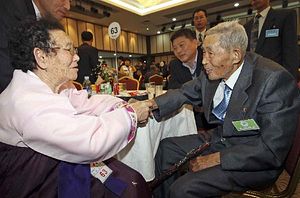The emotional scenes at the recent Korean reunion are a timely reminder of the stakes involved in Korean reunification and the extent to which both the people from the North and South have suffered over the past six decades. Amazingly, only about 1,900 of the 130,000 Koreans who have applied since 1988 have been physically reunited since the conflict ended in a truce. Stories such as those of Lee Soon-kyu, an 85-year old grandmother who was reunited with her husband Oh Se-in, whom she last saw 65 years ago while five months pregnant, bring home the humanitarian tragedy and the political failings in not finding a solution to reuniting a nation previously bound together for two millennia. The ages of the participants – more than 80 percent of current survivors are over 70, shows that time is running out for building a Korea based on direct family links.
While continuing its bluster over its nuclear weapons program, the North is edging towards closer relations with the South, at least for now. Kim Jong-un’s speech at the military parade to celebrate the seventieth anniversary of the foundation of the Korean Workers Party last week purposefully avoided references to nuclear weapons. Kim still needs foreign aid – he is modeling his leadership around providing greater economic autonomy, albeit on his terms. The vast amounts spent on Pyongyang since Kim took office, estimated at well over several billion dollars, including the updating of Pyongyang Sunan International Airport at a cost of $200 million dollars, the expensive 70th anniversary celebrations, and of course Kim Jong-un’s personal preferences, notably a penchant for black luxury Mercedes Benz sedans all need to be financed.
Kim Jong-un’s political need to show economic competence presents opportunities for the South in terms of inter-Korea trade. In 2011, the Ministry of Unification put trade figures at $1.7 billion with government and private humanitarian assistance to North Korea totaling about $17.4 million. While a return to the “Sunshine Policy” years, where the South provided large amounts of aid and actively pursued greater inter-Korean cooperation may not be on the top of the South’s agenda, it remains an option.
At the Korea Global Forum in the European Parliament earlier this month, South Korea’s Minister for Reunification Hong Yong-pyo was asked about a potential return to Kim Dae-jung’s Sunshine Policy and whether a new Inter-Korean summit between Kim Jong-un and Park Geun-hye could ever be a viable possibility. The minister responded more positively than many would expect, suggesting that a presidential summit is something being discussed seriously.
The Sunshine Policy decade led to 40 different types of agreements, including the development of the Kaesong industrial zone. Almost significant foundation stone for future reunification was laid during this period. A new summit may sound unrealistic at the moment, but with Kim Jong-un’s market-oriented reforms leading to the flourishing of some private markets with unofficial growth rates reportedly as high as 4 percent, political opportunities in developing economic links for the South may present themselves.
A new Inter-Korean summit could benefit both sides. For Pyongyang it would cement Kim Jong-un’s image as a relative modernizer, keen for better relations with the South, especially stronger trade relations. It would also help his standing with the Chinese leadership, which has weakened significantly. For Seoul, a summit would highlight Park’s foreign policy success and desire to promote future reunification. It could also play into a “hidden” strategy for the South.
In the long term, with private markets growing and individual wealth increasing, Kim may have a serious problem maintaining his political control when greater economic freedoms abound. This is why financial assistance from Park Geun-hye and a possible reigniting of some Sunshine Policy initiatives, such as more cooperation at Kaesong, where some 30,000 North Koreans were employed (all taking home hard currency) at the height of the policy. Trade also increased significantly across the demilitarized zones, reaching almost $2 billion with 1,000 people crossing the border each day. Offering similar economic carrots for North Korea today could be a sensible political strategy. In doing so, Seoul could provide a strong push in the way of more economic reforms, in doing so quietly moving North Korea towards more political liberalization.
Jack Hands is a former political advisor, having worked in the U.K. and European parliaments. He has written for several major political blogs, notably Conservative Home. Currently based in Korea, he was founder of North Korea Campaign UK, which campaigned for awareness of the plight of political prisoners inside North Korea. Follow him on Twitter @jackhands1.

































